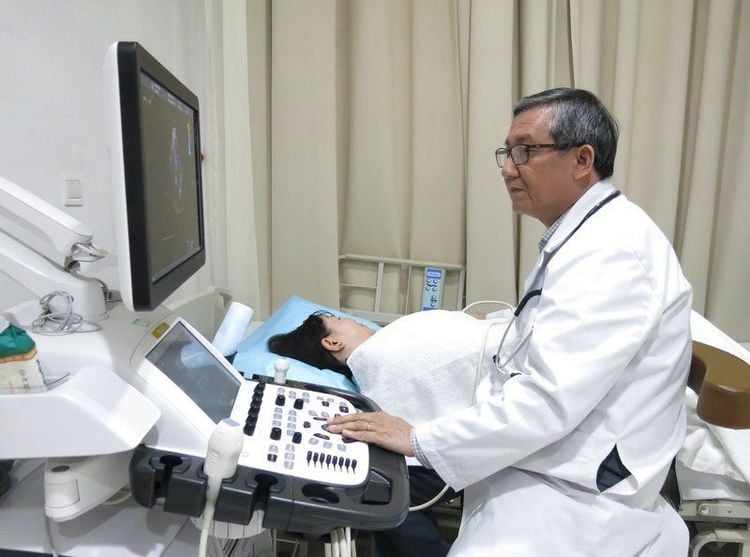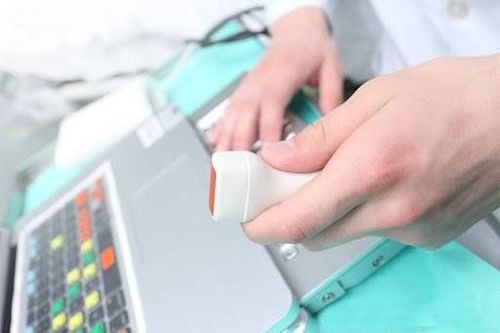This is an automatically translated article.
Basic echocardiography is one of the non-invasive, simple and effective exploratory techniques, helping doctors have the most general view of the morphology, function and hemodynamics of the heart wall, heart chambers, the pericardium or the large blood vessels connected to the heart.
1. What is a basic echocardiogram?
Ultrasound is a technique that uses a form of energy caused by mechanical impulses with frequencies above 20000 Hertz. Ultrasound waves are emitted regularly with a cycle of about 1,000 times / second and enter the body's organs. When the ultrasonic waves meet the organs, they will reflect back and reach the receiver and then be converted into electricity, amplified and displayed on the screen.
Basic echocardiography is one of the non-invasive, simple and effective exploratory techniques, helping doctors have the most general view of the morphology, function and hemodynamics of the heart wall, heart chambers, The pericardium or the large blood vessels connected to the heart... Depending on the location of the echocardiogram, the doctor may prescribe one-way ultrasound or two-dimensional ultrasound.
Clinically, echocardiography is classified according to the principle of operation and location of ultrasound. In particular, if based on the operating principle, there are 3 types of ultrasound, including: 1-D ultrasound (a way to probe the anatomical components of the heart), 2-D ultrasound (Helps see clearly anatomical slices). The heart's anatomy and images will be almost the same as the real anatomy), Doppler ultrasound (using continuous Doppler, pulse Doppler, organizational Doppler, color Doppler to help doctors examine morphological changes, cardiac function and hemodynamics). Based on the location of the ultrasound, there are two types: transthoracic echocardiography and transesophageal echocardiography.
The results of a basic echocardiogram will help the doctor know the size and shape, thickness and movement of the heart walls, how the heart moves, the pumping power of the heart, the heart valves of the patient are working. Is it normal, is it narrow or is there blood leaking out....
2. What is the role of basic echocardiography?
Basic echocardiography plays an important role in screening and diagnosing the patient's cardiovascular health, helping:
Provide accurate information about the shape of the heart such as the size of the heart heart chambers, status of heart valves, wall thickness... Provides information on left atrial, right atrial, left ventricular, right ventricular function (in which, the role of left ventricular function assessment is most important and has the most applications in the screening and treatment of cardiovascular diseases).
3. Basic sections in echocardiography

Siêu âm tim tại Bệnh viện Đa khoa Quốc tế Vinmec
Basic views in echocardiography that will be carefully monitored during ultrasound include:
Subcostal view Conduct exploration of subcostal ultrasound locations to evaluate the four chambers of the human heart. sick. With this technique, the doctor will tilt the transducer to the right to assess the inferior vena cava, then the patient needs to inhale to help assess the central venous pressure.
Parastenal view The parasternal ultrasound sites will be explored next to evaluate the left ventricle and compare the size of the heart chambers. In addition, the parasternal exploration also helps to localize the pericardial effusion and distinguish between pericardial effusion and pleural effusion most accurately.
Short-axis sternal view The short-axis sternal view in basic echocardiography helps to obtain images by rotating the transducer 90 degrees clockwise, and then scanning the transducer up from the base of the heart to the apex of the patient's heart to obtain different cross-sections.
Apical view Probing the apical view during baseline echocardiography is more difficult, however, this technique allows for comparison of ventricular chamber sizes and is the best window for evaluating cardiac abnormalities. motor abnormalities in the interventricular septum and heart wall.
4. Basic Echocardiography Guide
After being ordered by the doctor, the patient will have to follow the basic echocardiographic instructions, including the following specific steps:
The patient takes off his shirt and is applied a Gel to his chest to help increase the quality of the blood. the amount of image obtained and dimming the light in the ultrasound room. The doctor will proceed to adjust the machine to the ultrasound positions to see the image and parameters, if there is a problem during the ultrasound (the ultrasound detects a hole in the heart) or it is necessary. , to limit the possible risk, the patient will be injected with the drug. Each basic echocardiogram will take from 30 minutes to 1 hour, the ultrasound process is often combined with electrocardiogram measurement to get the most accurate results about the patient's health status.
5. When to conduct basic echocardiography?
After conducting a preliminary examination, the doctor will base on the patient's condition to prescribe basic echocardiography in cases.
Aortic dissection Assess left and right ventricular function Optimizing treatment: perform the procedure under ultrasound guidance Clinical scenario Detect pericardial effusion, compression Chest pain Acute respiratory failure Evaluation of cardiac function in the event of circulatory arrest Shock, hemodynamic instability Injury Circulatory arrest Instructions for pericardial drainage Measure inferior vena cava diameter and results Detect right ventricular dilatation, right ventricular failure Detects left ventricular dilatation, left ventricular failure and wall movement disorders Detects pericardial effusion, cardiac tamponade.

Bệnh nhân bị đau ngực có thể được chỉ định siêu âm tim cơ bản
6. What should be done after performing basic echocardiography?
Basic echocardiography is a non-invasive, painless technique, so patients can completely resume daily activities after the ultrasound. If the results are normal, no further tests are needed, however, if the results are abnormal, the patient may be referred to a cardiologist for further testing.
Indications for treatment will be based on the basic echocardiographic results, to be sure of their health, the patient can repeat echocardiography in a few months or discuss more with the doctor about their health status. Dear. In particular, when intending to screen for cardiovascular health, patients need to find out and go to a reputable and quality medical facility.
Cardiovascular Center - Vinmec Times City International General Hospital is the address for quality basic echocardiography. This is one of the leading centers in the country for examination, diagnosis, screening and treatment of cardiovascular diseases. With the convergence of a team of experienced, reputable experts in the field of surgery, internal medicine, interventional cardiac catheterization and the application of advanced techniques in the diagnosis and treatment of diseases. Cardiovascular management, together with a system of modern equipment, on par with the most prestigious hospitals in the world such as: MRI 3 Tesl a (Siemens), CT 640 (Toshiba), other equipment Advanced endoscopy equipment EVIS EXERA III (Olympus Japan), Avace advanced anesthesia system, Hybrid operating room according to international standards... Cardiovascular center at Vinmec Times City International General Hospital has reaped the benefits. achieved many successes and gained the trust of many patients.
Please dial HOTLINE for more information or register for an appointment HERE. Download MyVinmec app to make appointments faster and to manage your bookings easily.













